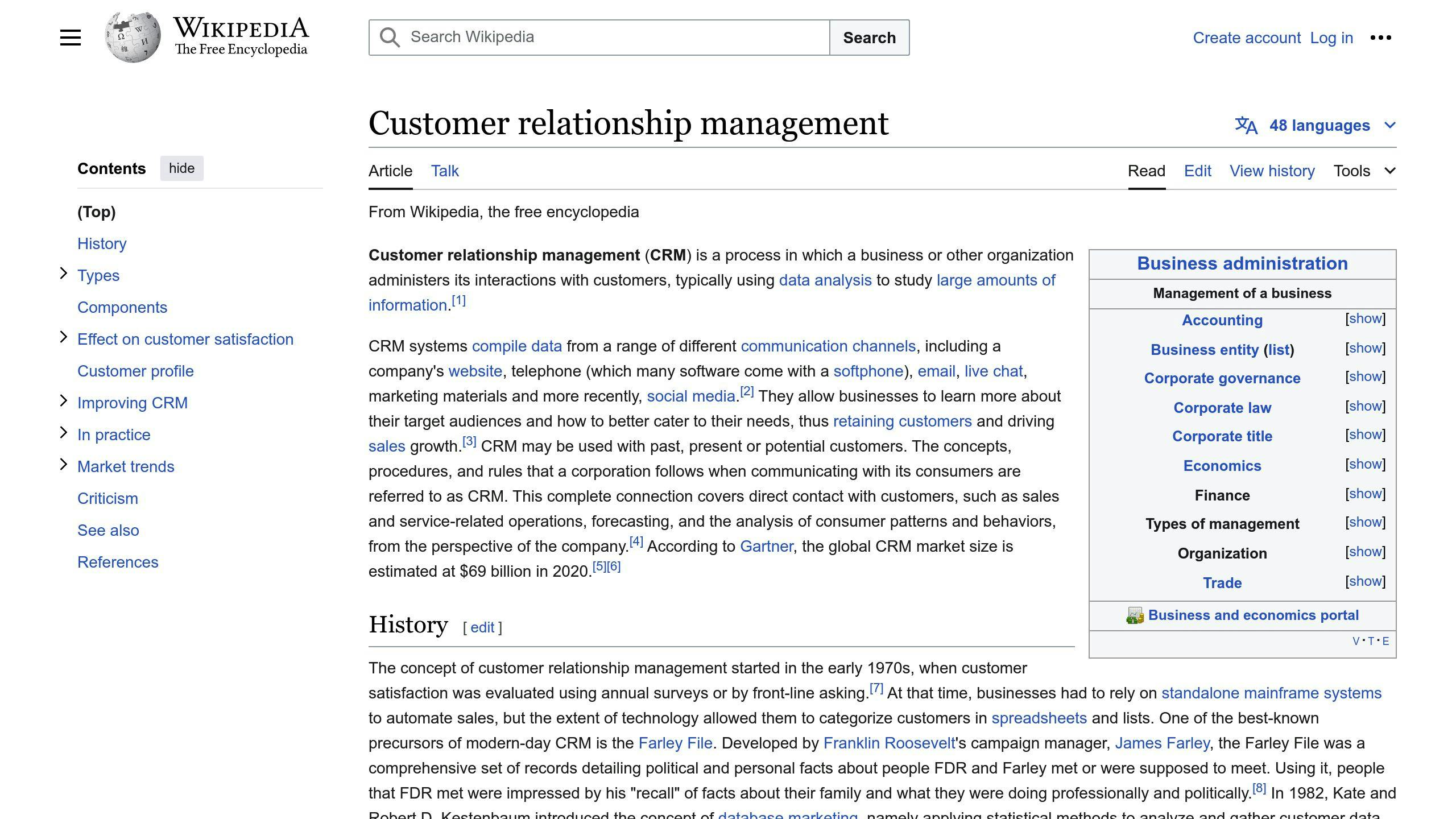Predictive analytics is transforming sales forecasting by using machine learning, statistical models, and data mining to analyze customer data, market trends, and sales performance. This data-driven approach offers several key benefits over traditional forecasting methods:
- Improved Accuracy: Predictive analytics analyzes large datasets to uncover patterns and insights that are not visible to human analysts, leading to more precise forecasts.
- Increased Efficiency: The forecasting process is automated, saving time and effort for sales teams.
- Better Decision-Making: Predictive analytics provides actionable insights that enable data-driven decisions to drive revenue growth.
To implement predictive analytics for sales forecasting, businesses should follow these steps:
-
Build and Train Models
- Collect and preprocess data from CRM systems, sales records, and external sources
- Select an appropriate algorithm (e.g., regression, decision trees, neural networks)
- Train the model using historical sales data
-
Evaluate Model Performance
- Use metrics like accuracy, precision, recall, and mean absolute error (MAE) to assess the model's performance
-
Monitor and Update Models
- Regularly monitor the model's performance
- Retrain the model with new data to keep up with market changes
- Continuously refine the model by adding new data sources, features, and algorithms
-
Communicate Results
- Present data insights using visualizations like charts and graphs
- Highlight key findings and recommendations from the model
- Provide context on assumptions, limitations, and potential biases
While predictive analytics offers powerful insights, it's essential to balance automation with human judgment, promote a data-driven culture, and address privacy and ethics considerations.
As AI and machine learning continue to advance, predictive analytics will become more powerful, integrating with emerging technologies like IoT and big data. Businesses that adopt these trends will be better positioned to make accurate sales forecasts, drive revenue, and stay competitive.
| Key Benefit | Description |
|---|---|
| Improved Accuracy | Analyzes large datasets to find patterns not visible to human analysts |
| Increased Efficiency | Automates the forecasting process, saving time and effort |
| Better Decision-Making | Provides actionable insights for data-driven decisions and revenue growth |
Related video from YouTube
Predictive Analytics in Sales
Predictive analytics is transforming sales by helping businesses make data-driven decisions. It uses statistical models, machine learning, and data mining to analyze past data and predict future sales outcomes.
What is Predictive Analytics?
Predictive analytics uses statistical models and machine learning to forecast future events. In sales, it analyzes customer data, market trends, and sales performance to predict future sales.
Why Accurate Sales Forecasts Matter
Accurate sales forecasts are crucial for business planning and decision-making. They help businesses:
- Allocate resources and budget effectively
- Spot new opportunities and risks
- Create targeted marketing campaigns
- Improve customer satisfaction and retention
Benefits Over Traditional Methods
Predictive analytics offers several advantages over older sales forecasting methods:
| Benefit | Description |
|---|---|
| Improved accuracy | Analyzes large datasets to find patterns not visible to human analysts. |
| Increased efficiency | Automates the forecasting process, saving time and effort. |
| Better decision-making | Provides actionable insights for data-driven decisions and revenue growth. |
Predictive Analytics Techniques
Predictive analytics in sales forecasting uses various methods to analyze customer data, market trends, and sales performance. These methods help businesses make informed decisions and improve revenue growth.
Modeling and Machine Learning
Predictive modeling and machine learning are key parts of predictive analytics. They use statistical algorithms to analyze large datasets and find patterns. Common techniques include:
| Technique | Description |
|---|---|
| Regression Analysis | Predicts continuous outcomes, like sales revenue, by finding relationships between variables. |
| Decision Trees | Classifies data into categories, useful for predicting outcomes like customer churn. |
| Neural Networks | Identifies complex patterns in data, useful for outcomes involving multiple variables. |
Data Preparation
Data preparation is crucial in predictive analytics. It involves collecting, cleaning, and preprocessing data to ensure high-quality inputs for models. Steps include:
| Step | Description |
|---|---|
| Data Cleansing | Removing missing or duplicate values. |
| Data Transformation | Converting data into a suitable format for analysis. |
| Feature Engineering | Creating new features from existing data to improve model performance. |
Integrating with CRM Systems

Predictive analytics tools can be integrated into CRM platforms to enhance sales forecasting. This involves:
| Step | Description |
|---|---|
| Data Integration | Connecting predictive tools with CRM systems to access customer data. |
| Model Deployment | Implementing predictive models within CRM systems to generate forecasts. |
| Result Visualization | Displaying predictive results within CRM systems to aid decision-making. |
Factors Affecting Forecast Accuracy
Accurate sales forecasting is key for making informed decisions and driving revenue growth. However, several factors can impact the accuracy of sales forecasts. Let's explore these factors and how to address them.
Data Quality and Completeness
High-quality and complete data are essential for accurate forecasts. Poor data quality can lead to errors, while incomplete data can result in missed opportunities. To ensure data quality, businesses should:
- Regularly cleanse and update their data
- Validate data against external sources
- Use data normalization techniques to ensure consistency
Identifying Relevant Variables
Identifying the most relevant variables that impact sales predictions is critical for accuracy. Businesses should:
- Analyze historical data to find patterns and correlations
- Use feature engineering to create new features from existing data
- Select the most relevant variables using techniques like recursive feature elimination
Handling Seasonality and Trends
Seasonality and market trends can significantly impact sales forecasts. To account for these factors, businesses should:
- Use time-series analysis to identify seasonal patterns
- Incorporate trend analysis to capture long-term changes
- Use techniques like seasonal decomposition to separate seasonal and trend components
Incorporating External Factors
External factors like economic conditions, industry trends, and weather can also impact sales forecasts. To incorporate these factors, businesses should:
- Use external data sources like economic indicators and weather data
- Analyze the impact of external factors on sales using techniques like regression analysis
- Incorporate external factors into predictive models to improve accuracy
sbb-itb-b22f30c
Implementing Predictive Analytics
Predictive analytics can greatly improve sales forecasting, but it needs careful planning and execution. This section will guide you through building, evaluating, and maintaining predictive models for sales forecasting.
Building and Training Models
To create a predictive model, follow these steps:
- Collect and preprocess data: Gather data from CRM systems, sales records, and external sources. Clean and preprocess the data to ensure accuracy and consistency.
- Select an algorithm: Choose an algorithm that fits your data and goals, such as linear regression, decision trees, or neural networks.
- Train the model: Use historical sales data to train the model and adjust its parameters for better performance.
Evaluating Model Performance
It's important to check how well your model is performing. Use these metrics:
| Metric | Description |
|---|---|
| Accuracy | Proportion of correct predictions out of total predictions. |
| Precision | Proportion of true positives out of total positive predictions. |
| Recall | Proportion of true positives out of total actual positive instances. |
| Mean Absolute Error (MAE) | Average difference between predicted and actual values. |
Monitoring and Updating Models
Predictive models need regular updates to stay accurate. Here are some tips:
- Monitor performance: Regularly check the model's performance using the metrics above.
- Update the model: Re-train the model with new data to keep up with market changes.
- Refine the model: Continuously improve the model by adding new data sources, features, and algorithms.
Communicating Results
Sharing the results of predictive analytics is key to making informed business decisions. Here are some tips:
- Use visualizations: Present data insights with charts and graphs for clarity.
- Focus on insights: Highlight key findings and recommendations from the model.
- Provide context: Explain the assumptions, limitations, and potential biases of the results.
Best Practices and Challenges
Overcoming Data Integration Issues
Data integration can be tricky when using predictive analytics for sales forecasting. To tackle this, make sure your CRM system connects with other data sources like marketing platforms, product analytics, and social media tools. This gives a full view of customer interactions. Use data integration tools to combine different sources into one unified view.
Promoting a Data-Driven Culture
A data-driven mindset is key for using predictive analytics effectively. Educate your sales team on the benefits and how it can improve their forecasts. Provide training and support to help them use predictive insights. Encourage a mindset of continuous improvement where data-driven decisions are valued.
Privacy and Ethics Considerations
When using predictive analytics, it's important to think about privacy and ethics. Make sure you have customer consent to collect and use their data. Protect customer data from unauthorized access or misuse. Be transparent about how you use customer data and offer opt-out options if needed.
Balancing Human Insights and Automation
While predictive analytics offers valuable insights, it's important to balance automation with human judgment. Sales teams should use automated predictions along with their own expertise. This ensures that forecasts are both accurate and well-informed. Combining human insights with automation leads to better forecasting outcomes.
Future Trends and Advancements
Predictive analytics in sales forecasting is evolving, with new trends and advancements shaping the field.
AI and Machine Learning Advancements
AI and machine learning are making predictive analytics more powerful. With more AI tools available, businesses can make better sales predictions. Large language models (LLMs) and AI chatbots will help users of all skill levels make accurate forecasts. This will allow businesses to use data from many sources to predict future sales.
Integrating with Emerging Technologies
Predictive analytics can work with technologies like IoT and big data for deeper insights. IoT connects devices to the internet, allowing data collection and exchange. In sales forecasting, IoT devices can provide real-time data on product usage, service needs, and customer readiness for new purchases, leading to more accurate predictions.
Personalized Sales and Customer Experience
Predictive analytics can help create personalized sales strategies and improve customer experiences. By analyzing customer data, businesses can find patterns and preferences, allowing them to tailor their sales approaches and offer targeted solutions. This personalized approach can increase customer satisfaction, loyalty, and revenue.
As predictive analytics continues to grow, businesses that adopt these trends will be better at making accurate sales forecasts, driving revenue, and staying competitive.
Conclusion
Key Takeaways
Predictive analytics has changed how businesses forecast sales. By using machine learning, historical data, and external factors, companies can make accurate predictions, boost revenue, and stay competitive.
This guide covered the benefits of predictive analytics in sales forecasting, such as better accuracy, increased confidence, and improved ROI. We also discussed challenges like data quality, complexity, and the need for a data-focused culture.
To start with predictive analytics, businesses should:
- Build a strong data foundation
- Identify key variables
- Integrate with CRM systems
By following best practices and addressing common challenges, companies can fully use predictive analytics to succeed.
Remember, predictive analytics is an ongoing process. It needs regular monitoring, evaluation, and updates. Staying current with trends and advancements helps businesses stay competitive and meet their revenue goals.
Start using predictive analytics today to improve your sales forecasting and drive business growth.



